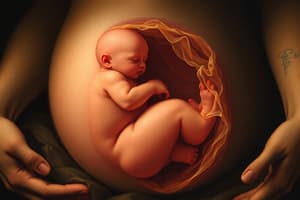Podcast
Questions and Answers
During pregnancy, which lung volume or capacity experiences the most significant increase?
During pregnancy, which lung volume or capacity experiences the most significant increase?
- Tidal Volume (TV) (correct)
- Inspiratory Capacity (IC)
- Residual Volume (RV)
- Expiratory Reserve Volume (ERV)
Which of the following best describes the change in Functional Residual Capacity (FRC) during pregnancy, and what contributes to this change?
Which of the following best describes the change in Functional Residual Capacity (FRC) during pregnancy, and what contributes to this change?
- FRC increases due to increased chest wall compliance.
- FRC decreases primarily because of the enlarging uterus. (correct)
- FRC increases significantly due to hormonal effects on the respiratory muscles.
- FRC remains unchanged as inspiratory and expiratory volumes balance out.
A pregnant woman is experiencing shortness of breath. Based on the physiological changes of pregnancy, which of the following is the MOST likely contributing factor?
A pregnant woman is experiencing shortness of breath. Based on the physiological changes of pregnancy, which of the following is the MOST likely contributing factor?
- Decreased Tidal Volume (TV) reducing overall ventilation effectiveness.
- Increased Vital Capacity (VC) causing discomfort during deep breaths.
- Increased Residual Volume (RV) leading to hyperinflation of the lungs.
- The enlarging uterus decreasing Functional Residual Capacity (FRC). (correct)
How does pregnancy affect Total Lung Capacity (TLC), and what is the primary reason for this change?
How does pregnancy affect Total Lung Capacity (TLC), and what is the primary reason for this change?
A physician is evaluating a pregnant patient with concerns about her respiratory function. Which combination of changes in lung volumes and capacities is MOST expected during the patient's third trimester?
A physician is evaluating a pregnant patient with concerns about her respiratory function. Which combination of changes in lung volumes and capacities is MOST expected during the patient's third trimester?
A pregnant patient in her second trimester presents with a grade II systolic ejection murmur at the left sternal border. This murmur is most likely attributed to:
A pregnant patient in her second trimester presents with a grade II systolic ejection murmur at the left sternal border. This murmur is most likely attributed to:
During pregnancy, cardiac output increases primarily due to an increase in:
During pregnancy, cardiac output increases primarily due to an increase in:
Echocardiography in a pregnant woman at 20 weeks gestation is likely to reveal left ventricular hypertrophy characterized by:
Echocardiography in a pregnant woman at 20 weeks gestation is likely to reveal left ventricular hypertrophy characterized by:
Which of the following valvular changes is LEAST likely to occur as a physiological adaptation during normal pregnancy?
Which of the following valvular changes is LEAST likely to occur as a physiological adaptation during normal pregnancy?
The point of maximal cardiac impulse (PMI) in a pregnant woman at term is typically displaced:
The point of maximal cardiac impulse (PMI) in a pregnant woman at term is typically displaced:
Central venous pressure, pulmonary artery diastolic pressure, and pulmonary capillary wedge pressure during normal pregnancy are typically:
Central venous pressure, pulmonary artery diastolic pressure, and pulmonary capillary wedge pressure during normal pregnancy are typically:
The increase in left ventricular end-diastolic volume without a proportional increase in left ventricular filling pressure during pregnancy is best explained by:
The increase in left ventricular end-diastolic volume without a proportional increase in left ventricular filling pressure during pregnancy is best explained by:
Myocardial contractility during pregnancy is expected to:
Myocardial contractility during pregnancy is expected to:
What is the primary reason for the increase in brachial artery blood pressure observed in some term pregnant women in the supine position?
What is the primary reason for the increase in brachial artery blood pressure observed in some term pregnant women in the supine position?
The supine hypotension syndrome in pregnant women is characterized by which sequence of events?
The supine hypotension syndrome in pregnant women is characterized by which sequence of events?
What is the underlying physiological cause of supine hypotension syndrome in pregnant women?
What is the underlying physiological cause of supine hypotension syndrome in pregnant women?
According to the provided information, how does the lateral position affect intra-abdominal pressure in term pregnant patients?
According to the provided information, how does the lateral position affect intra-abdominal pressure in term pregnant patients?
What happens to the inferior vena cava in a term pregnant woman when she lies in the supine position?
What happens to the inferior vena cava in a term pregnant woman when she lies in the supine position?
How does collateral circulation contribute to venous return in term pregnant women experiencing caval compression?
How does collateral circulation contribute to venous return in term pregnant women experiencing caval compression?
What percentage elevation above baseline of femoral venous and lower inferior vena cava pressures is consistent with findings by angiography in some term pregnant women?
What percentage elevation above baseline of femoral venous and lower inferior vena cava pressures is consistent with findings by angiography in some term pregnant women?
Which of the following best describes the relationship between BMI and intra-abdominal pressure in term pregnant patients?
Which of the following best describes the relationship between BMI and intra-abdominal pressure in term pregnant patients?
During the late phase of the third trimester in normotensive pregnant patients, what happens to the Left Ventricular Stroke Work Index (LVSWI) as Pulmonary Capillary Wedge Pressure (PCWP) increases?
During the late phase of the third trimester in normotensive pregnant patients, what happens to the Left Ventricular Stroke Work Index (LVSWI) as Pulmonary Capillary Wedge Pressure (PCWP) increases?
Based on the cardiac output changes throughout pregnancy, labor and postpartum, when does cardiac output reach its peak?
Based on the cardiac output changes throughout pregnancy, labor and postpartum, when does cardiac output reach its peak?
What percentage change from pre-pregnant levels does heart rate (HR) increase during gestation?
What percentage change from pre-pregnant levels does heart rate (HR) increase during gestation?
What happens to Systemic Vascular Resistance (SVR) during gestation, and what percentage change does it undergo?
What happens to Systemic Vascular Resistance (SVR) during gestation, and what percentage change does it undergo?
Which hemodynamic parameter does not change during gestation?
Which hemodynamic parameter does not change during gestation?
During which period does cardiac output experience the most significant increase relative to pre-pregnancy levels?
During which period does cardiac output experience the most significant increase relative to pre-pregnancy levels?
According to the figure representing Left Ventricular function, what range of PCWP (Pulmonary Capillary Wedge Pressure) values correlates with a 'normal' LVSWI (Left Ventricular Stroke Work Index)?
According to the figure representing Left Ventricular function, what range of PCWP (Pulmonary Capillary Wedge Pressure) values correlates with a 'normal' LVSWI (Left Ventricular Stroke Work Index)?
What characterizes the pattern of cardiac output change across the trimesters of pregnancy?
What characterizes the pattern of cardiac output change across the trimesters of pregnancy?
If a pregnant patient exhibits a 40% increase in cardiac output during the second trimester, what corresponding change in stroke volume (SV) would likely contribute to this increase, assuming heart rate (HR) remains relatively stable?
If a pregnant patient exhibits a 40% increase in cardiac output during the second trimester, what corresponding change in stroke volume (SV) would likely contribute to this increase, assuming heart rate (HR) remains relatively stable?
Based on the provided figures, how does labor affect cardiac output compared to the third trimester of pregnancy?
Based on the provided figures, how does labor affect cardiac output compared to the third trimester of pregnancy?
What is the primary hormonal influence on the increase in minute ventilation during pregnancy?
What is the primary hormonal influence on the increase in minute ventilation during pregnancy?
How does the PaCO2 typically change during the first trimester of pregnancy compared to the nonpregnant state?
How does the PaCO2 typically change during the first trimester of pregnancy compared to the nonpregnant state?
What is the typical change in tidal volume observed during pregnancy?
What is the typical change in tidal volume observed during pregnancy?
How does the arteriovenous oxygen difference change as pregnancy progresses?
How does the arteriovenous oxygen difference change as pregnancy progresses?
Why might a pregnant woman in the supine position after mid-gestation have a PaO2 less than 100 mm Hg (13.3 kPa)?
Why might a pregnant woman in the supine position after mid-gestation have a PaO2 less than 100 mm Hg (13.3 kPa)?
What is the expected blood pH level during pregnancy?
What is the expected blood pH level during pregnancy?
By what percentage does alveolar ventilation increase above baseline during pregnancy?
By what percentage does alveolar ventilation increase above baseline during pregnancy?
How does the CO2-ventilatory response curve change during pregnancy?
How does the CO2-ventilatory response curve change during pregnancy?
Why does serum creatinine concentration decrease during pregnancy?
Why does serum creatinine concentration decrease during pregnancy?
What is the typical range for creatinine clearance in a pregnant woman at term?
What is the typical range for creatinine clearance in a pregnant woman at term?
How does the filtration fraction change during pregnancy, and why?
How does the filtration fraction change during pregnancy, and why?
What happens to blood urea nitrogen (BUN) concentration during the first trimester of pregnancy?
What happens to blood urea nitrogen (BUN) concentration during the first trimester of pregnancy?
When do renal hemodynamic alterations typically return to pre-pregnancy levels postpartum?
When do renal hemodynamic alterations typically return to pre-pregnancy levels postpartum?
What happens to gastric volume during labor?
What happens to gastric volume during labor?
How does gastric acid secretion change during labor, based on gastric pH levels?
How does gastric acid secretion change during labor, based on gastric pH levels?
When does gastric emptying return to pre-pregnancy levels after delivery?
When does gastric emptying return to pre-pregnancy levels after delivery?
Flashcards
Grade II Systolic Ejection Murmur
Grade II Systolic Ejection Murmur
A heart sound often heard during pregnancy at the left sternal border.
Stroke Volume Increase in Pregnancy
Stroke Volume Increase in Pregnancy
Increase in blood pumped by the heart with each beat, rising 20% in the first trimester and 25-30% above baseline in the second.
Left Ventricular Hypertrophy in Pregnancy
Left Ventricular Hypertrophy in Pregnancy
Enlargement of the heart muscle, especially the left ventricle, due to increased blood volume and workload.
Cardiac Impulse Shift
Cardiac Impulse Shift
Signup and view all the flashcards
Tricuspid and Pulmonic Valve Regurgitation
Tricuspid and Pulmonic Valve Regurgitation
Signup and view all the flashcards
Aortic Annulus Changes
Aortic Annulus Changes
Signup and view all the flashcards
Increased Myocardial Contractility
Increased Myocardial Contractility
Signup and view all the flashcards
Left Ventricular End-Diastolic Volume in Pregnancy
Left Ventricular End-Diastolic Volume in Pregnancy
Signup and view all the flashcards
Tidal Volume (TV)
Tidal Volume (TV)
Signup and view all the flashcards
Total Lung Capacity (TLC)
Total Lung Capacity (TLC)
Signup and view all the flashcards
Residual Volume (RV)
Residual Volume (RV)
Signup and view all the flashcards
Expiratory Reserve Volume (ERV)
Expiratory Reserve Volume (ERV)
Signup and view all the flashcards
Inspiratory Reserve Volume (IRV)
Inspiratory Reserve Volume (IRV)
Signup and view all the flashcards
Cardiac Output in Pregnancy
Cardiac Output in Pregnancy
Signup and view all the flashcards
Stroke Volume Increase
Stroke Volume Increase
Signup and view all the flashcards
Heart Rate Increase
Heart Rate Increase
Signup and view all the flashcards
SVR Decrease
SVR Decrease
Signup and view all the flashcards
LVEDV Increase
LVEDV Increase
Signup and view all the flashcards
PCWP Stability
PCWP Stability
Signup and view all the flashcards
LVSWI in Pregnancy
LVSWI in Pregnancy
Signup and view all the flashcards
CVP During Pregnancy
CVP During Pregnancy
Signup and view all the flashcards
PADP During Pregnancy
PADP During Pregnancy
Signup and view all the flashcards
LVESV considerations
LVESV considerations
Signup and view all the flashcards
Angiography
Angiography
Signup and view all the flashcards
Venous Pressure Elevation
Venous Pressure Elevation
Signup and view all the flashcards
Collateral Circulation in Pregnancy
Collateral Circulation in Pregnancy
Signup and view all the flashcards
Intra-abdominal Pressure During Pregnancy
Intra-abdominal Pressure During Pregnancy
Signup and view all the flashcards
Inferior Vena Cava Compression
Inferior Vena Cava Compression
Signup and view all the flashcards
Brachial Artery BP Increase (Supine)
Brachial Artery BP Increase (Supine)
Signup and view all the flashcards
Supine Hypotension Syndrome
Supine Hypotension Syndrome
Signup and view all the flashcards
Cause of Supine Hypotension
Cause of Supine Hypotension
Signup and view all the flashcards
PaCO2 During Pregnancy
PaCO2 During Pregnancy
Signup and view all the flashcards
pH During Pregnancy
pH During Pregnancy
Signup and view all the flashcards
Bicarbonate During Pregnancy
Bicarbonate During Pregnancy
Signup and view all the flashcards
Tidal Volume Increase
Tidal Volume Increase
Signup and view all the flashcards
Respiratory Rate Increase
Respiratory Rate Increase
Signup and view all the flashcards
Alveolar Ventilation Increase
Alveolar Ventilation Increase
Signup and view all the flashcards
Progesterone's Respiratory Effect
Progesterone's Respiratory Effect
Signup and view all the flashcards
Gastric Emptying in Labor
Gastric Emptying in Labor
Signup and view all the flashcards
Gastric Acid Secretion
Gastric Acid Secretion
Signup and view all the flashcards
Creatinine Clearance in Pregnancy
Creatinine Clearance in Pregnancy
Signup and view all the flashcards
Filtration Fraction
Filtration Fraction
Signup and view all the flashcards
BUN Concentration During Pregnancy
BUN Concentration During Pregnancy
Signup and view all the flashcards
GFR Changes in Pregnancy
GFR Changes in Pregnancy
Signup and view all the flashcards
Renin and Aldosterone
Renin and Aldosterone
Signup and view all the flashcards
Blood Volume Increase
Blood Volume Increase
Signup and view all the flashcards
Study Notes
- Anatomic and physiologic changes occur during pregnancy to allow adaptation to the developing fetus and its metabolic needs.
- Recognizing these changes is key to managing pregnant women under anesthesia.
Body Weight and Composition
- Average maternal weight gain is 17% of pre-pregnancy weight, or about 12 kg.
- Weight contributed from the uterus and contents accounts for approximately 6kg:
- Uterus: 1 kg
- Amniotic fluid: 1 kg
- Fetus and placenta: 4 kg
- Approximately 2 kg of weight results from increases in blood volume and interstitial fluid
- Fat and protein deposition total approximately 4 kg of the weight increase
- The Institute of Medicine recommends weight gain based on pre-pregnancy body mass index (BMI), reflecting obesity trends
- A nonobese individual is expected to gain 1-2 kg during the first trimester
- There is expected gain of around 5-6kg in each of trimesters two and three
- A long-term increase in BMI is associated with excessive weight gain during pregnancy.
Cardiovascular Changes
- The heart increases in size due to increased blood volume and stronger contractions.
Physical Examination and Cardiac Studies
Changes during pregnancy include:
- The expanding uterus raises the diaphragm
- The first heart sound (S1) is accentuated, with exaggerated splitting of the mitral and tricuspid components
- Systolic ejection murmur is typical
- Presence of third (S3) and fourth (S4) heart sounds may occur with no clinical significance
- The point of maximal cardiac impulse moves toward the left
- Left ventricular (LV) hypertrophy occurs by 12 weeks' gestation
- Increase in LV mass increases 23% from the first to the third trimester
- Increase in LV mass increases by around 50% in final term
- Diameter in mitral, tricuspid, and pulmonic valves increase
- Tricuspid and pulmonic regurgitation present in 94% of pregnant women at term
- Mitral regurgitation present in 27% of pregnant women at term
- There are no normal dilation changes in the aortic annulus
- Third trimester electrocardiogram changes:
- Heart rate steadily climbs during the first and second trimesters
- The PR and uncorrected QT intervals shorten
- QRS axis shifts right in first trimester, possibly shifting left in the third
- ST segments become depressed, and isoelectric low-voltage T waves appear in the left-sided precordial and limb leads.
Studying That Suits You
Use AI to generate personalized quizzes and flashcards to suit your learning preferences.




